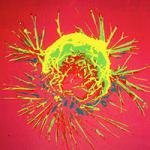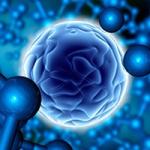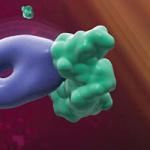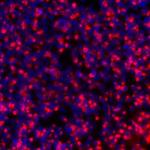
Research Topics
Role of NKX2-1 in thyroid regeneration and carcinogenesis
NKX2-1 is a critical transcription factor for the genesis of thyroid, lung, ventral forebrain, and pituitary, and is essential for the maintenance of normal architecture and function of the differentiated thyroid as demonstrated by Nkx2-1-null and Nxk2-1-thyroid specific conditional-null mice, respectively. Our previous research suggested that NKX2-1 may be related to the maintenance and/or activity of thyroid stem/progenitor cells, the disturbance of which leads to thyroid carcinogenesis, and a balance of expression/no-expression of NKX2-1 may be critical if a thyroid differentiates or proceeds to carcinogenesis. It is known that in thyroid cancers, the degree of dedifferentiation generally correlates with the decreased level of NKX2-1 expression.
Our current research focuses on the role of NKX2-1 in thyroid regeneration using partial thyroidectomy mouse model with the hypothesis that the stem/progenitor cells may be activated under partial thyroidectomy. We found that a cluster of thin and elongated shaped NKX2-1-positive cells were found located near the tracheal cartilage and muscle, some of which were connected to a newly formed follicle-like structure with round shaped NKX2-1 positive cells. Experiments are being carried out to understand the nature of NKX2-1-positive cluster of cells that appear after partial thyroidectomy.
Role of novel cytokine-like immune modulatory molecule secretoglobin (SCGB) 3A2
SCGB3A2 was initially identified as a downstream target for NKX2-1 in lung by suppressive subtractive hybridization method using Nkx2-1-null vs. wild-type mouse embryo lungs. SCGB3A2 is predominantly expressed in lung, with only very weak expression in the thyroid. We have demonstrated multiple SCGB3A2 functions in the lung; 1) Anti-inflammatory activity initially by administration of adenovirus expressing SCGB3A2 to the ovalbumin allergic airway inflammation model mice, later by use of Scgb3a2-null mice. 2) Growth factor activity promoting embryonic lung development and branching morphogenesis using ex vivo embryonic lung organ culture and in vivo administration of recombinant SCGB3A2 to pregnant female mice, 3) Anti-fibrotic activity using bleomycin-induced pulmonary fibrosis model mice with the administration of SCGB3A2 protein, and by use of Scgb3a2-null and Scgb3a2-lung-specific overexpressing transgenic mice, 4) Airway and carcinoma markers, 5) Anti-cancer activity, and recently 6) anti-emphysematous activity. For the anti-cancer activity of SCGB3A2, we identified syndecan-1 (SDC1), a member of the transmembrane heparan sulfate (HS) proteoglycan family, as a SCGB3A2 receptor by use of human protein-protein interaction microarrays. SCGB3A2 is an LPS-binding protein and chaperones LPS to cell cytosol through SCGB3A2-LPS complex binding to SDC1. Internalized LPS is a known activator of the non-canonical inflammasome pathway, that leads to inflammatory cell death, also known as pyroptosis. We discovered that cells expressing SDC1 on their cell surfaces with abundant HS and caspase-4 (CASP4), the critical molecule in the non-canonical inflammasome pathway, regardless of origins of cancers, are susceptible to SCGB3A2-induced growth inhibition in the presence of LPS in vitro and in in vivo xenograft model mice. Our current research focuses on 1) To determine the extent of SCGB3A2/LPS-induced cell growth inhibition using various cancer cell lines derived from many different organs, and 2) To understand the tumor microenvironment affected by SCGB3A2. This project emphasizes the translational aspect of research, which leads to development of SCGB3A2 as a therapeutic to treat cancers.
Biography
Selected Publications
- Murata T, Iwadate M, Takizawa Y, Miyakoshi M, Hayase S, Yang W, Cai Y, Yokoyama S, Nagashima K, Wakabayashi Y, Zhu J, Kimura S. An Adult Mouse Thyroid Side Population Cell Line that Exhibits Enriched Epithelial-Mesenchymal Transition. Thyroid. 2017;27(3):460-474.
- Yoneda M, Xu L, Kajiyama H, Kawabe S, Paiz J, Ward JM, Kimura S. Secretoglobin Superfamily Protein SCGB3A2 Alleviates House Dust Mite-Induced Allergic Airway Inflammation in Mice. Int Arch Allergy Immunol. 2016;171(1):36-44.
- Cai Y, Winn ME, Zehmer JK, Gillette WK, Lubkowski JT, Pilon AL, Kimura S. Preclinical evaluation of human secretoglobin 3A2 in mouse models of lung development and fibrosis. Am J Physiol Lung Cell Mol Physiol. 2014;306(1):L10-22.
- Snyder EL, Watanabe H, Magendantz M, Hoersch S, Chen TA, Wang DG, Crowley D, Whittaker CA, Meyerson M, Kimura S, Jacks T. Nkx2-1 represses a latent gastric differentiation program in lung adenocarcinoma. Mol Cell. 2013;50(2):185-99.
- Okamoto M, Hayase S, Miyakoshi M, Murata T, Kimura S. Stem cell antigen 1-positive mesenchymal cells are the origin of follicular cells during thyroid regeneration. PLoS One. 2013;8(11):e80801.
Related Scientific Focus Areas


Molecular Biology and Biochemistry
View additional Principal Investigators in Molecular Biology and Biochemistry


This page was last updated on Tuesday, July 25, 2023